What are the Proper Guidelines for Mounting a Fire Extinguisher?
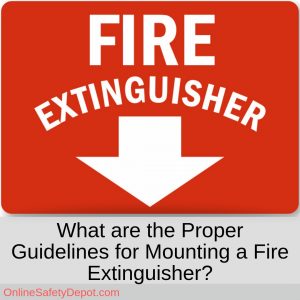
Portable fire extinguishers are the first line of defense in combating a fire that has started in a home or commercial building. If accessed promptly, a single person can extinguish a fire in its initial stages with a portable fire extinguisher before it grows too large to control, or before damage to furniture, fixtures, carpet or other items occurs should a buildings fire sprinkler system be activated. As such, all fire extinguishers in a building should be readily accessible and easily identifiable for quick and unimpeded access.
There are various approved ways to install or mount a fire extinguisher. The National Fire Protection Association (NFPA) codes (NFPA 10: Standard for Portable Fire Extinguishers) stage that a fire extinguisher should be securely installed/mounted on the hanger or bracket supplied by the vendor, or placed in a special fire extinguisher cabinet, or recessed into a wall. If you secure the fire extinguisher using a hanger or bracket, you must follow the manufacturer’s instructions to secure it properly. A fire extinguisher that weighs 40 lbs. or less must be installed so that the top of the canister is no more than 5 ft above the floor. A fire extinguisher that weighs more than 40 lbs. must be installed so the top of the canister is nor more than 3.5 ft above the floor. Also, in the case of both these installation guidelines, the bottom of the extinguisher must be at least 4 ft off the floor to prevent setting the extinguisher on the floor as a permeant location.
Extinguishes are often installed/mounted along frequently trafficked corridors, near entrances and exits to the building. To secure the fire extinguishers, they should be mounted in one of the following standardized methods:
- Extinguisher Cabinet: the cabinets may be mounted to the surface of the wall, semi-recessed into the wall, or fully-recessed into the wall. A benefit of housing an extinguisher in a cabinet is that the cabinet can include a break-front panel that has proven to be a deterrent to theft and tampering as to access the extinguisher requires actually breaking the panel which would produce sounds and possibly alert individuals nearby that someone is tampering.
- Hanger: specifically designed for the type of extinguisher being mounted, which typically comes with the extinguisher.
- Bracket: a strap-type bracket that helps ensure that the extinguisher does not become dislodged.
Note: Fire extinguishers rated not less than 2A, should be provided for every 3,000 square feet of protected building area, or major fraction thereof. Further, fire extinguishers for use by employees on Class A fires shall be placed so that the travel distance for employees to any extinguisher is 75 feet or less.
In addition to the proper placement and mounting of a fire extinguisher, the successful use and function of a fire extinguisher requires that the fire extinguisher be the correct type for the fire that has occurred (the type of fire that can occur based on the types of fuel in the setting where the extinguisher is located), the fire is discovered while still in the early stages where it can be effectively extinguished by a portable fire extinguisher, and that the fire is discovered by an individual who is properly trained, willing, and physically capable to use the extinguisher.
Purchase Wall or Vehicle Brackets at OnlineSafetyDepot.com
-
Product on sale
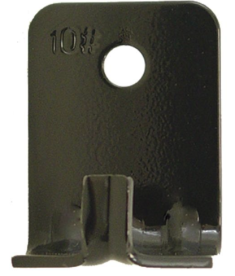 Badger™ Wall Hook (For 10 lb ABC Extinguishers)Original price was: $38.85.$29.85Current price is: $29.85.
Badger™ Wall Hook (For 10 lb ABC Extinguishers)Original price was: $38.85.$29.85Current price is: $29.85. -
Product on sale
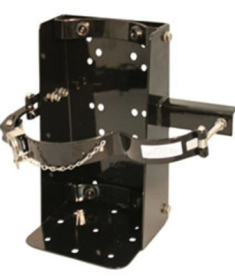 Badger™ Clamp-Type Vehicle Bracket (For 10 & 15 lb CO2 Extinguishers)Original price was: $114.85.$94.85Current price is: $94.85.
Badger™ Clamp-Type Vehicle Bracket (For 10 & 15 lb CO2 Extinguishers)Original price was: $114.85.$94.85Current price is: $94.85. -
Product on sale
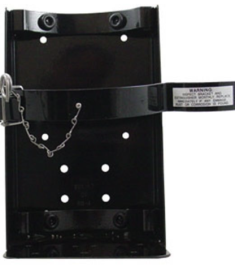 Badger™ Vehicle Bracket (For 20 lb Extinguishers)Original price was: $128.85.$114.85Current price is: $114.85.
Badger™ Vehicle Bracket (For 20 lb Extinguishers)Original price was: $128.85.$114.85Current price is: $114.85. -
Product on sale
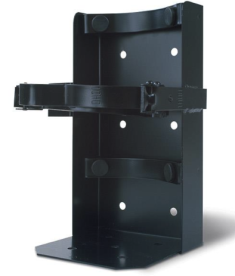 Amerex® Universal Vehicle Brackets – (Fits 6 1/2″–7″ Dia Shells)Original price was: $126.99.$113.25Current price is: $113.25.
Amerex® Universal Vehicle Brackets – (Fits 6 1/2″–7″ Dia Shells)Original price was: $126.99.$113.25Current price is: $113.25. -
Product on sale
 Amerex® Universal Vehicle Brackets – (Fits 5 3/4″–6 1/4″ Dia Shells)Original price was: $116.99.$103.25Current price is: $103.25.
Amerex® Universal Vehicle Brackets – (Fits 5 3/4″–6 1/4″ Dia Shells)Original price was: $116.99.$103.25Current price is: $103.25. -
Product on sale
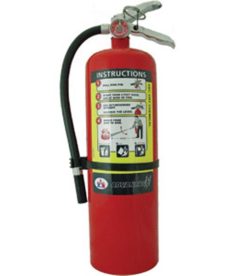 Badger™ Advantage™ Extinguisher 10-Pound ABC-Class with Wall BracketOriginal price was: $194.94.$180.13Current price is: $180.13.
Badger™ Advantage™ Extinguisher 10-Pound ABC-Class with Wall BracketOriginal price was: $194.94.$180.13Current price is: $180.13.
What are the Proper Guidelines for Signs to Identify Where a Fire Extinguisher is Located?
Fire extinguisher safety signs are designed to assist individuals in quickly locating a fire extinguisher. OSHA only requires that fire extinguisher location be “identified so that they are readily accessible to employees without subjecting the employees to possible injury”. Prudence indicates that signage be such that the extinguisher location be visible from near and far away, from different angles, and that signs protrude 90° from the mounting wall making them highly visible from both sides, especially if the cabinet is recessed into the wall. Of course, common sense dictates that there is nothing of a permeant structure, an open door, or anything piled that obstructs the view of the sign.
These signs are often made of corrosion resistant materials so they can be used in indoor and outdoor areas. Select models come with glow in the dark properties so the extinguisher can be identified in dark areas, at night, or in blackout situations.
